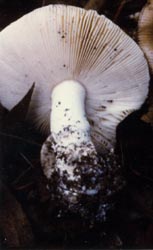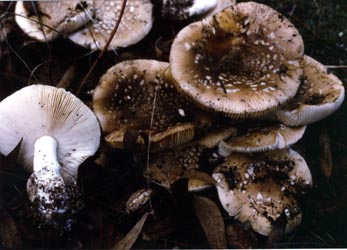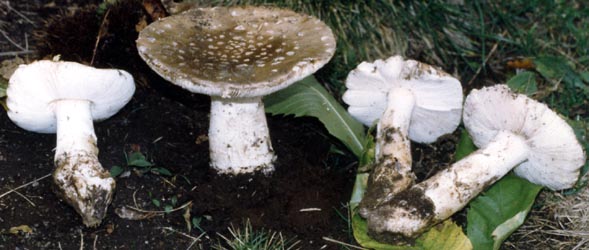[ Section Amanita page. ] [ Amanita Studies home. ] [ Keys & Checklist/Picturebooks ]
Amanita gioiosa S. Curreli ex S. Curreli"Pebbly Soil Amanita"




Technical description (t.b.d.)
BRIEF DESCRIPTION: The description is predominantly based on the two papers of Curreli (1990, 2000). The cap of A. gioiosa is (60-) 70 - 100 (-140) mm wide, cream at the edge and progressively becoming brown from the center outwards or entirely brown or, in several examples, ash-gray, darkest in the center, globose at first, becoming hemispherical to convex, finally depressed in the center in mature material, often marked with random and shallow indentations, and having a short-striate margin. The form of the cap is often irregular. The cap skin is easily peeled. The cap is covered with shallow, farinose warts, at first whitish, cream-white, and easily removed in humid conditions. The flesh is white and firm.
The gills are free, whitish to white-cream at maturity, fairly thick, with a serrate edge. Short gills are present.
The stem is (60-) 70 - 120 (-160) × 15 - 20 mm [length apparently includes length of bulb], expanded at the top, white, smooth, with a bulbous base. The bulb is radicating. The stem has an elliptical cross-section. At maturity, the stipe's ring can take the form of a belt and is not very evident. In many examples, the ring is absent at maturity (see below). The volva is only present at the base of the stem as a narrow limb at the top of the bulb. [Note: This information about the volva is our interpretation based on dried specimens and illustrations of Curreli (1990, 2000) and Neville and Poumarat (2004).] The flesh is white, compact, stuffed at maturity.
According to the original description, the spores of A. gioiosa measure (8-) 9 - 11 (-12) × (6-) 7 - 7.7 (-8) µm and are broadly ellipsoid to ellipsoid and inamyloid. Neville and Poumarat (2004) report that the spores measure 8 - 11.5 (-13) × (5.5-) 6 - 8.5 (-9.5) µm and are broadly ellipsoid to ellipsoid (occasionally elongate) and inamyloid. Spores measured by RET (Sardinian material courtesy Dr. M. Contu) are as follows: (8.0-) 8.9 - 11.5 (-13.4) × (6.5-) 7.0- 9.0 (-9.5) µm and are broadly ellipsoid to ellipsoid and inamyloid. According to Neville and Poumarat, clamps are common at bases of basidia.
The present species occurs in large groups, sometimes in groups with the bases growing together, or solitarily, in wooded areas with Eucalyptus and an under story of Cistus on pebbly, sandy sand and also in diverse, mixed forests with the presence of broad-leaved trees. The species was originally described from Sardinia, Italy. Neville and Poumarat state that it is more widespread around the Mediterranean and indicate association with Arbutus, chestnut (Castanea), oak (Quercus), and pine (Pinus).
This species could have been introduced with Eucalyptus or could be a native Mediterranean species that is actually growing with Cistus, rather than Eucalyptus. The belt-like ring is placed rather low on the stem, but is apparently not the analogue of the rings on the base of the stem in species belongs in the group with Amanita muscaria (L. : Fr.) Lam..
One of the illustrations of the present species included by Neville and Poumarat (2004) shows that the ring originally connects the stipe to the cap margin and that, at that time, it is membranous and of rather small radius. [ Return to description of stem. ]
The reader should compare the present species with Amanita heterochroma S. Curreli since they both appear in the same habitat.
The best available description is that of Neville and Poumarat (2004). -- R. E. Tulloss and L. Possiel
Photos courtesy of Dr. S. Curreli (Sardinia, Italy)
[ Section Amanita page. ] [ Amanita Studies home. ] [ Keys & Checklist/Picturebooks ]
Last change 7 October 2009
This page is maintained by R. E. Tulloss.
Copyright 2006, 2007, 2009 by Rodham E. Tulloss.
Photos copyright 2006 by Dr. S. Curreli.